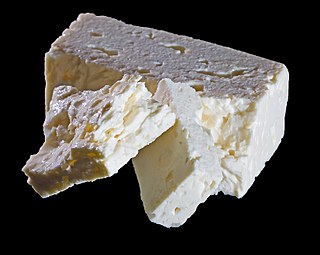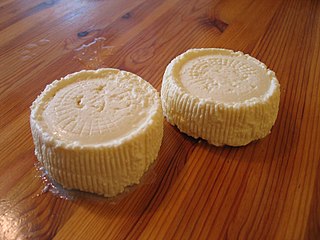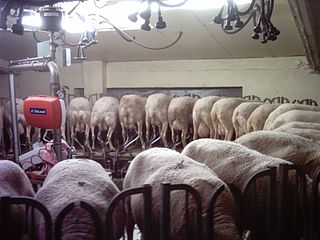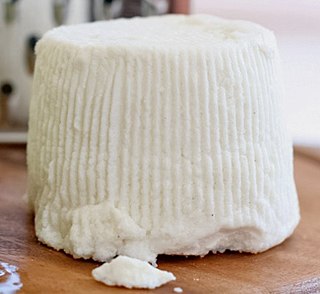
Pecorino romano is a hard, salty Italian cheese made from sheep's milk, often used for grating over pasta or other dishes. The name pecorino means 'ovine' or 'of sheep' in Italian; the name of the cheese, although protected, is a description rather than a brand: [formaggio] pecorino romano means 'sheep's [cheese] of Rome'.

Feta is a Greek brined white cheese made from sheep milk or from a mixture of sheep and goat milk. It is soft, with small or no holes, and no skin. Crumbly with a slightly grainy texture, it is formed into large blocks and aged in brine. Its flavor is tangy and salty, ranging from mild to sharp. Feta is used as a table cheese, in salads such as Greek salad, and in pastries, notably the phyllo-based Greek dishes spanakopita "spinach pie" and tyropita "cheese pie". It is often served with olive oil or olives, and sprinkled with aromatic herbs such as oregano. It can also be served cooked, as part of a sandwich, in omelettes, and many other dishes.

Goat cheese, goat's cheese or chèvre is cheese made from goat's milk. Goats were among the first animals to be domesticated for producing food. Goat cheese is made around the world with a variety of recipes, giving many different styles of cheeses, from fresh and soft to aged and hard.

Ricotta is an Italian whey cheese made from sheep, cow, goat, or Italian water buffalo milk whey left over from the production of other cheeses. Like other whey cheeses, it is made by coagulating the proteins that remain after the casein has been used to make cheese, notably albumin and globulin.

Bryndza or brynza is a sheep milk cheese made across the countries in Central and Eastern Europe, most notably in Slovakia. Bryndza cheese is creamy white in appearance, known for its characteristic strong smell and taste. The cheese is white, tangy, crumbly and slightly moist. It has characteristic odor and flavor with a notable taste of butyric acid. The overall flavor sensation begins slightly mild, then goes strong and finally fades to a salty finish. Recipes differ slightly across countries.

Sirene, also known as "white brine sirene", is a type of brined cheese originating from Bulgaria. It is made of the milk of goats, sheep, cows, buffalo or a mixture thereof. It is slightly crumbly, with at least 46–48% of dry matter containing 44–48% of fat. It is commonly produced in blocks, and has a slightly grainy texture. It is used as a table cheese, in salads, and in baking.

Brocciu is a Corsican cheese produced from a combination of milk and whey, giving it some of the characteristics of whey cheese. It is produced from ewe's milk. It is notable as a substitute for lactose-rich Italian Ricotta, as brocciu contains less lactose.

Strained yogurt, Greek or Greek-style yogurt, yogurt cheese, sack yogurt, kerned yogurt or labneh is yogurt that has been strained to remove most of its whey, resulting in a thicker consistency than normal unstrained yogurt, while still preserving the distinctive sour taste of yogurt. Like many types, strained yogurt is often made from milk enriched by boiling off some water content, or by adding extra butterfat and powdered milk. In Europe and North America, it is often made from low-fat or fat-free cow's milk. In Iceland a similar product named skyr is made.

Sheep milk is the milk of domestic sheep. It is commonly used to make cultured dairy products, such as cheese. Some of the most popular sheep cheeses include feta (Greece), Pecorino romano (Italy), Roquefort (France) and Manchego (Spain).

There are many different types of cheese, which can be grouped or classified according to criteria such as: length of fermentation, texture, production method, fat content, animal source of the milk, and country or region of origin. These criteria may be used either singly or in combination, with no method used universally. The most common traditional categorization is based on moisture content, which is then further narrowed down by fat content and curing or ripening methods.

Cheeses in Mexico have a history that begins with the Spanish conquest, as dairy products were unknown in pre-Columbian Mesoamerica. The Spanish brought dairy animals, such as cattle, sheep, and goats, as well as cheesemaking techniques. Over the colonial period, cheesemaking was modified to suit the mixed European and indigenous tastes of the inhabitants of New Spain, varying by region. This blending and variations have given rise to a number of varieties of Mexican cheeses. These are most popular in the country, although European cheeses are made, as well. Almost all cheese in Mexico is made with cows’ milk, with some made from goats’ milk. More recently, efforts have been made to promote sheep's milk cheeses. Most cheeses are made with raw (unpasteurized) milk. Cheeses are made in the home, on small farms or ranches, and by major dairy product firms. Between 20 and 40 different varieties of cheese are made in Mexico, depending on how one classifies them. Some, such as Oaxaca and panela, are made all over Mexico, but many are regional cheeses known only in certain sections on the country. Some of the least common are in danger of extinction.

Whey cheese is a dairy product made of whey, the by-product of cheesemaking. After the production of most cheeses, about 50% of milk solids remain in the whey, including most of the lactose and lactalbumin. The production of whey cheese allows cheesemakers to use the remaining whey, instead of discarding it as a waste product.

The cuisine of Corsica is the traditional cuisine of the island of Corsica. It is mainly based on the products of the island, and due to historical and geographical reasons, has much in common with Italian cuisine, and marginally with those of Nice and Provence.

Faisselle is a non-protected French cheese made of raw milk from cows, goats, or sheep. The name comes from the mold in which the cheese is strained: faisselle.































